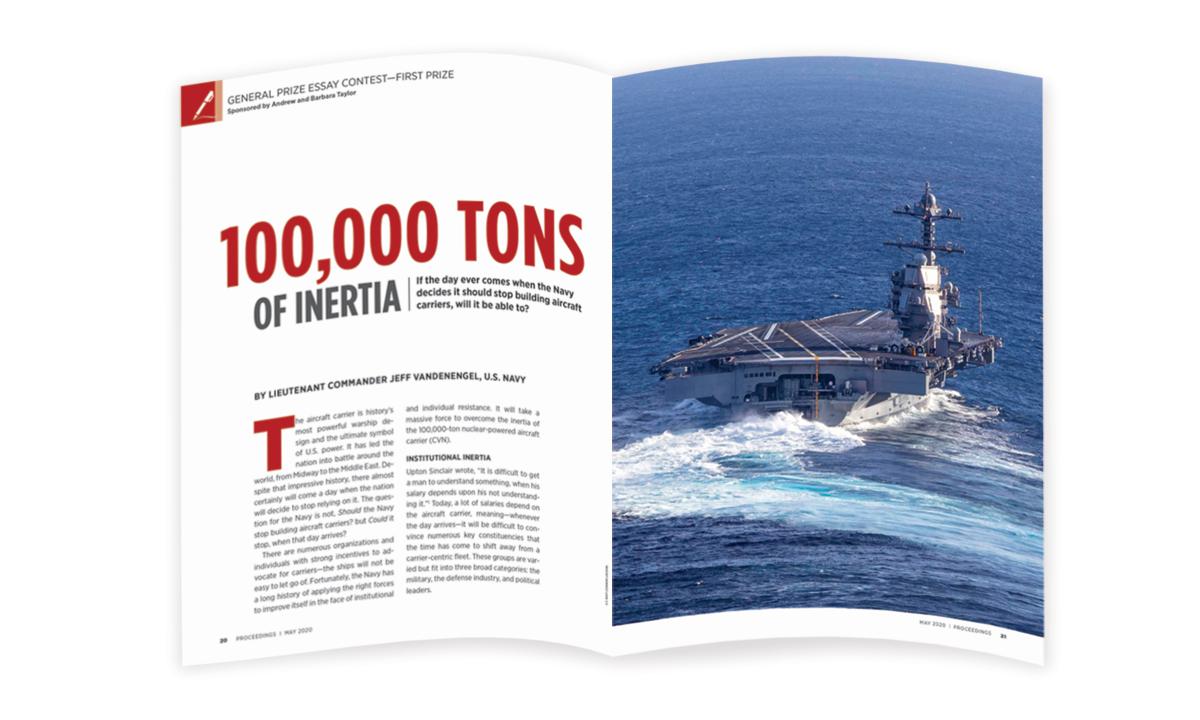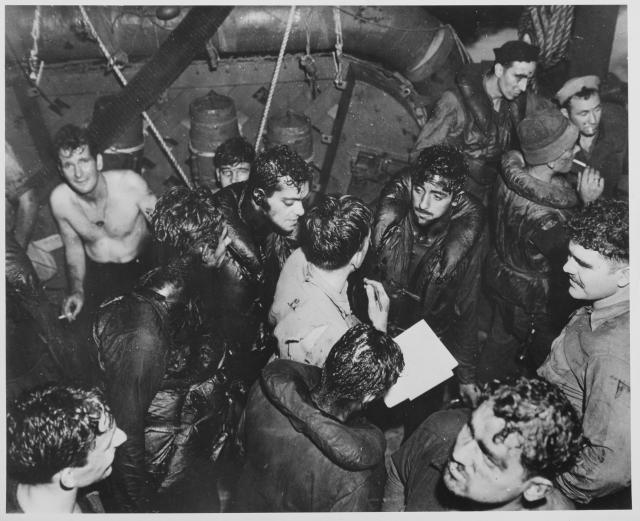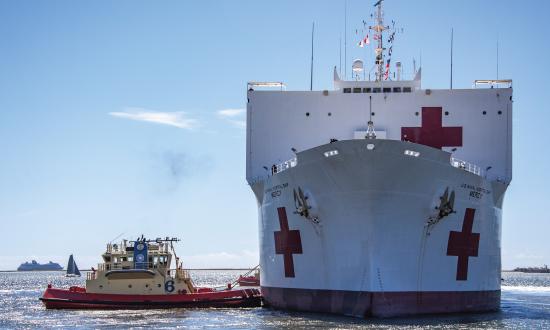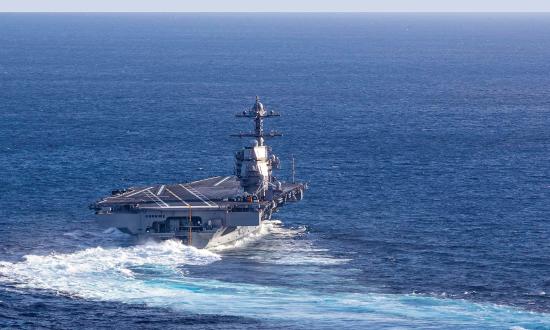100,000 Tons of Inertia
(See J. Vandenengel, pp. 20–25, May 2020, and W. Toti, pp. 86–87, June 2020)
Thank you to Captain Toti for providing feedback on my essay, which was fortunate enough to win the General Prize Essay Contest. I attempted to answer the question, “If the day ever comes when the Navy decides it should stop building aircraft carriers, will it be able to?” The essay emphasized institutional and individual inertia and how to overcome it.
Captain Toti argued that my “logic is flawed,” that I only cited “irrelevant factoids,” that the article contained numerous “logical weaknesses,” and that I was misusing statistics by “conflating correlation with causality.”
Focusing on his last allegation, I do not understand how the evidence I cited could be construed as mere correlations. I explored multiple factors that could cause organizations to resist the demise of aircraft carriers (CVNs). I cannot prove they will cause those organizations to resist its demise because it has not happened yet. That is how conflicts of interest work. It is impossible in most cases to prove an individual or organization will make a decision (e.g., judging the future of the aircraft carrier) for the right reasons (objectively evaluating the problem) or the wrong ones (power, status, or financial incentive).
The demise of the carrier indisputably would have a serious impact on the aviation community’s pilot and flag billets. Retired senior naval officers working for defense contractors indisputably have influence on appropriations. And the Aircraft Carrier Industrial Base Coalition indisputably is a lobbying organization specifically devoted to advocating for the “importance of our nation’s aircraft carriers” and ensuring a “stable industrial base.” These organizations all have strong incentives that could cause them to resist eliminating nuclear-powered aircraft carriers; these are not coincidences or correlations. Identifying the incentives now can help the Navy overcome them when the time is right; nowhere in the article do I assert that these groups definitely will resist a change in fleet structure because of them.
Captain Toti continues with a clever straw-man attack. Despite my entirely avoiding the should question, acknowledging it could be decades before the question is called, he attacks the idea anyway, citing the small magazine size and long regeneration times of submarines and surface combatants as proof against an argument I never made.
To the contrary, in the article I argue that the Navy should not move on from the carrier unless it has a better alternative, which at present it does not. I approvingly cited Admiral Chester Nimitz, who said, “What determines the obsolescence of a weapon is not the fact that it can be destroyed, but that it can be replaced by another weapon that performs its functions more effectively.”
I knew an article that touched on carrier production, political influence, and the defense industry’s employment of senior retired naval officers would generate some strong opinions, and I welcome critique of my work. I only hope such feedback will focus on what I actually wrote.
—LCDR Jeff Vandenengel, USN
After 50 years reading Proceedings, I have found very few issues that did not offer something for everyone in the profession of arms, but the May 2020 Naval Review was the best I can recall. The features were all excellent and thought provoking. The finest was Lieutenant Commander Vandenengel’s.
It is remarkable, and reassuring, that the essay received the first prize in the General Prize Essay Contest. The author should be commended for an incisive discussion of a serious issue and for taking on “the powers that be.” Challenge the gods! It is a good day when a mid-level officer can fearlessly do so.
I expected this essay would raise hackles, and it certainly did in June’s Comment & Discussion department. Captain Toti’s comments missed the mark and showed he fundamentally did not understand the article’s thesis.
—COL Charles D. McFetridge, USA (Ret.)
FONOPs: Not the Only Option
(See P. Valerín, N. Chounet, J. Smith, and K. Kotov, pp. 42–47, May 2020)
The authors advance a lot of great ideas, but the article ignores the proverbial gorilla in the corner: The United States has not ratified the U.N. Convention on the Law of the Sea (UNCLOS), even though the United States was a key author of the Convention, considers its provisions customary law, and follows its rules scrupulously. China has ratified it, yet openly flaunts it.
The article’s proposals—a multi-national fisheries initiative, development of a “South China Sea Code of Conduct,” and asking China to adopt the 2014 Code for Unplanned Encounters at Sea—are excellent and necessary ideas. Yet they work only within the framework of the Convention. It is increasingly difficult for us to demonstrate any “political will to defend the international rules-based order” when we repeatedly succumb to our own internal partisan divisiveness. Ratification of UNCLOS is more urgent than ever.
—CDR David A. Buzard, JAGC, USNR (Ret.)
Naming the Future Doris Miller (CVN-81)
(See R. Alley, p. 8, March 2020; L. Moyer, p. 88, April 2020; and T. Phillips, pp. 147–48, May 2020)
I disagree with Lieutenant Commander Phillips’ characterization of then–Acting Secretary of the Navy Thomas Modly’s decision to name CVN-81 in honor of Petty Officer Doris Miller as a “politically motivated travesty.” While Lieutenant Commander Phillips does accurately point to the ever- changing ship-naming conventions, he misses a few key points.
When Congress authorized the funding of a Navy in 1794, the authority for naming ships was given to President George Washington, who personally selected the names of the first 6 frigates from a list of 15 possibilities he was presented with. By an 1819 Act of Congress, “All of the ships of the navy of the United States . . . shall be named by the Secretary of the Navy, under the direction of the President of the United States.”
In the 20th century, the naming conventions at least tended to remain consistent within ship types, but there have been numerous exceptions of names given as political favors, many of which Lieutenant Commander Phillips lists.
So why the uproar now over naming a CVN for Doris Miller? He distinguished himself in action on 7 December 1941 and was awarded the Navy Cross. For these actions to be recognized in a segregated Navy serving a segregationist country was almost unheard of. Yet, Petty Officer Miller rose to the occasion, continued serving in ships, and ultimately gave his life in action serving a nation that still saw him as inferior (certainly the case in his home state of Texas, where Jim Crow laws were in effect).
Given that Representative Carl Vinson and Senator John C. Stennis were staunch segregationists who opposed racial integration of institutions including the Navy, perhaps it is far past time to name a national asset such as a carrier for a sailor who disregarded the harsh reality in which he lived to voluntarily expose himself to enemy fire to defend his ship and shipmates.
Naming this carrier will serve to remind Americans of how bad things used to be and how we should be proud of the diversity today’s Navy enjoys. The media rarely mentions ships named for figures in the Civil Rights Movement. Military Sealift Command ships such as the USNS Carl Brashear (T-AKE-7), USNS Medgar Evers (T-AKE-13), and USNS Cesar Chavez (T-AKE-14), don’t get very much press; aircraft carriers do. When this ship is commissioned in several years, Petty Officer Miller will again be mentioned widely in the press. This will be more than simply naming a ship for Doris Miller.
—CDR E. A. Coop, USN
Count Ships Differently
(See R. Rubel, pp. 42–46, June 2020)
Captain Rubel’s case for a “bifurcated fleet design” is a classic example of arguments that discount the importance of the combat capabilities of naval forces exercising “presence.”
In making the case for reducing the naval force structure in 1975, then–Secretary of Defense James R. Schlesinger wrote: “Political justifications for military deployments, however relevant, rarely provide the basis for specific numbers and types of forces. . . . A corporal’s guard may be as effective as a division if our main purpose is merely to demonstrate . . . presence in an area.”
There are two important problems with Captain Rubel’s argument. The first he shares with the late Secretary Schlesinger. Both discount the fact that perceptions of the combat potential of naval forces exercising presence have everything to do with their effectiveness in deterring or compelling inimical actors. The relevant perceptions are those of opposing forces, not foreign offices—and certainly not the media. An ill-equipped constabulary present at a crisis setting may trigger consequences far more dangerous than the constable’s “absence.”
The second problem is really one of position and geography. While the author is right to imply that since the end of the Cold War, the United States has confronted adversaries from relative sanctuaries at sea, China’s emergence and Russia’s resurgence will likely complicate “constabulary work” in the future, wherever we choose to deploy a presence.
I will not belabor the tired term “warfighting” (which was coined when nuclear planners wanted to differentiate “counterforce” from “countervalue“ strikes). Suffice it to note that forces that deploy from home waters must be configured to match the putative threats they may confront. Therefore, the number of “shooters” required should be determined as a function of acceptable risk and expected attrition in challenging maritime settings. The unfathomable alternative would be to retreat and reconfigure a rump Navy as a “Home Fleet.”
—RADM Philip A. Dur, USN (Ret.)
Make Mine Warfare A Team Sport
(See R. Brodie, pp. 46–50, April 2020)
As a former surface warfare officer (22 years of service) and an ocean engineer/naval architect, I read Commander Brodie’s article with interest. He correctly identified the challenges that our Navy and joint forces face in mine warfare.
Commander Brodie offered up some innovative solutions for clearing mines and pointed out some of the technical flaws with mine countermeasures systems currently in development. While he gave a nodding acknowledgment to unmanned systems, those of us who have also “been there” at sea and worried about minefields realize that an unmanned solution is the only way to keep sailors and Marines out of harm’s way.
I have worked with unmanned surface vehicles for a large part of my post-Navy career and was one of the chief design engineers of the DARPA Sea Hunter, now in development as one of the Navy’s medium unmanned surface vehicles (USVs). I am currently also bringing to the field the MANTAS USV, a 38-foot-long, catamaran-hull, commercial off-the-shelf (COTS) craft that, when configured with COTS minehunting and mine-neutralization systems, could be put in the water to defeat sea mines today.
I believe addressing the mine countermeasures challenge with COTS systems that have been wrung out in Navy and Marine Corps exercises, experiments, and demonstrations can further accelerate our ability to clear deadly minefields. While programs of record are developing next-generation technology, in the near term the Navy should also invest in parallel-path solutions that leverage mature components to provide a speed-to-capability solution today.
—LCDR U. H (Jack) Rowley, USN (Ret.)
A Guide to Reading Fleet Tactics
(See T. Beall, pp. 32–34, May 2020)
I share Captain Beall’s lament at the passing of Captain Wayne Hughes and will miss the clarity and elegance of Hughes’ writing. Though it is true that we will no longer benefit directly from his insights in future editions of this text, refinement of the Hughesian approach to naval tactics can continue.
Seminal textbooks in many fields live beyond their original authors, with subsequent editions being revised and carefully tended by experts in the discipline. Though Captain Hughes is irreplaceable, his legacy can continue—if the next generation of tacticians takes up the mantle and continues to update his work for the benefit of practitioners of the art and science of naval warfare.
—Victor Sussman
(See M. Cancian and B. Schwartz, pp. 52–57, April 2020; D. Burnett, E. Higgins, B. Haas, M. Cancian, and B. Schwartz pp. 8–9, May 2020)
Colonel Cancian and Mr. Schwartz’s article, based on the defective and biased legal analysis in the sidebar, “U.S. Privateering Is Legal,” has unsurprisingly generated significant public attention, including in the People’s Republic of China. The author’s proposal to revive privateering is plainly contrary to Article 2(4) of the UN Charter, which prohibits the threat or use of force between member states.
Mr. Schwartz’s legal analysis is flawed because he rejected and dismissed without reservation the established legal literature’s universally held understanding that customary international law prohibits piracy, including privateering. He must have appreciated that he was arguing against the literature by providing a radical alternative interpretation, given that he cited some of these contrary sources in footnote 3. Nonetheless, he failed to give such sources any due consideration; misrepresented his alternative arguments as legal certainties; and failed to disclose that his assertions are radical and likely to be disputed—as this response attempts to do.
The authors’ assertion that “privateering is not piracy” because privateering would be legally regulated by domestic law is no longer defensible under contemporary international law. For example, Article 101 of the UN Convention on the Law of the Sea defines piracy as any act of violence or depredation committed on the high seas by a private actor acting for private ends. Privateering satisfies this contemporary definition: Commission under domestic law is no longer a defense to this international crime, as the privateer is a private actor, albeit licensed, acting for private financial ends. Schwartz omitted that—despite Congress having the enumerated power to “define and punish” piracy—Congress defines and prohibits piracy in accordance with “the law of nations” (18 U.S. Code §1651), rather than with an alternative national definition that excludes privateering. Congress’s power to grant Letters of Marque is an anachronism that should either be repealed or never again applied, as has been the U.S. position since 1815.
The most important legal issue omitted is that piracy is recognized by the legal literature as being prohibited by nonderogable jus cogens, in addition to being prohibited by customary international law. Jus cogens (or peremptory norms) are fundamental principles of international law that cannot be deviated from. They have special status as compelling law and prevent the United States from relying on any of its potential objections to the applicability of customary international law against it, such as the persistent objector rule that Mr. Schwartz’s argument relied on. His argument thus fails.
The United States can never revive privateering without breaching contemporary international law. Whatever the solution to a conflict between China and the United States may be, it is not state-sponsored piracy.
One further note: The Naval Institute is incorrectly but easily associated with the U.S. Navy and government because of its official-sounding name and its offices at the U.S. Naval Academy. Proceedings’ submission guidelines and contents page in the print edition admirably note that “the Naval Institute is not an agency of the U.S. government; the opinions expressed in these pages are the personal views of the authors.” However, the same disclaimer is absent from each article’s webpage, which means that online readers who read only a specific article will never see it nor appreciate its implications. In the future, Proceedings should include a disclaimer with opinion articles the same as in the magazine to prevent spreading potential misunderstanding and unnecessary disagreement. This would be in accordance with the policies of most other publications.
Indeed, the personal opinion expressed by the authors of “Unleash the Privateers!” has been misconstrued and mistranslated, unfairly or not, by Chinese-language media as warmongering expressions of the “U.S. military.” This has led to misunderstanding by Chinese “netizens” and unnecessarily offended amity by sowing distrust and disharmony between the two countries.
—Leon Xiao
Eight Ways to Be Successful in the Navy
(See D. Smith, pp. 18–19, May 2020)
Congratulations to Petty Officer Smith for her insights. She packed a great deal of tightly focused wisdom into two pages. As I read her article, I thought back over my career, and I firmly believe that the best officers and sailors I worked with, led, and mentored were all following her sound advice, as were my own mentors. I would commend her article to anyone looking for a blueprint for success in the Navy—and in life.
—CAPT Greg Ulses, USN (Ret.)
Petty Officer Smith nails it. Her insights apply to more than just naval careers. Individuals have to take interest in their personal careers by working hard, projecting a positive attitude (especially on the difficult days), making a plan for themselves (more than, “This sucks, so I’m getting out!”), and exploring any and all professional opportunities.
I took advantage of the Navy’s educational opportunities beginning some 36 years ago. Through a combination of Navy schools, college courses, exams, and experience, I earned an associate’s degree while on active duty. My technical experience and degree gave me the needed qualifications to get my first professional job, but it quickly became apparent my career would not progress without more experience and more education—a necessity that drove me to complete both a bachelor’s and a graduate degree. Soon after completing them, professional certifications became necessary, too.
More than just a means for advancement, professional development has to be a way of life. While I’m not one to push for early adoption of new technology (neither is the Navy, for that matter), some projections say the world can expect technology to advance more in the next ten years than it has since the beginning of time. Those who stay on top of their fields will never want for employment. Those who embrace these changes stand to be the next generation of leaders.
While I wish Petty Officer Smith every success with her naval career, if she ever decides to make a change, I hope she will look me up. Her article projects the attitude, critical thinking, and writing skills that hiring managers fight for.
—Nick Wulfekuhle
Naval Aviation and Weapons In Review
(See T. Bodine and G. Snodgrass, pp. 81–87, May 2020)
The recent naval aviation review failed to note the efforts of Fleet Air Reconnaissance Squadron One (VQ-1), the Navy’s largest operational aviation squadron. VQ-1’s Worldwatchers operate the EP-3E Aries, the Navy’s most capable intelligence and reconnaissance platform, which maintains a wide global presence. EP-3E crews fly daily in the Fifth, Sixth, and Seventh Fleet areas of responsibility to provide real-time intelligence.
Though the planned sundown of VQ-1 has loomed for years, it has consistently shifted rightward. The fleet of EP-3Es continues to provide necessary information to decision-makers at all levels, while also serving as an operational testbed for the systems and sensors of follow-on platforms.
The sensitive nature of VQ-1’s signals intelligence missions means that its successes are often private, appreciated only by supported commanders and the intelligence community. Despite this necessary secrecy, VQ-1 plays an important role in the Navy’s mission, and the contributions of the EP-3E and its crews deserve recognition.
—LT Matt Little, USN
No Time For Victory
(See D. Rielage and T. Hone, pp. 36–41,
May 2020)
I want to thank the authors for writing what many military officers and civilians alike are too proud or too afraid to admit: Leaders are often so immersed in their daily battle rhythms that they do not have time to focus on other, often much more important, aspects of their profession and their lives—especially their own health and well-being and that of their staffs, who are obligated to keeping up with the boss’s frenetic pace.
The leadership cases contained in the article are very poignant, in particular the tragic loss of one of the Navy’s finest flag officers, Vice Admiral Scott “Sterno” Stearney, to an apparent suicide in December 2018. The NCIS investigation cited the long hours the admiral worked and the time away from his family as contributing factors. No one wants to admit that the current OpTempo is unsustainable. The authors do the Navy, Marine Corps, and Coast Guard a great service by recalling the habits of some of the finest admirals and generals in military history. Men such as Chester Nimitz, Ernest King, and George Marshall knew that to fight effectively to win, they must take a step back at times and recharge.
Mr. Hone’s and Captain Rielage’s article could not have come at a better time. In a culture that constantly increases demand while often limiting resources, leaders must take time to preserve and develop themselves and their teams.
—Zack Lunney
New Hospital Ships are Needed
(See S. Mercogliano, pp. 12–13, May 2020)
Dr. Mercogliano is to be commended for raising this important issue. While I agree that new hospital ships are needed, his suggestion to convert cruise ships to hospital ships overlooks the poor seakeeping abilities of cruise ships.
While these vessels have the capacity and mechanical systems to function as hospital ships, cruise ships are designed for calm-water cruising. Their shallow drafts and huge sail areas make them ill-suited for transit through or service in even moderately rough seas. The cited vessels pressed into service during the 1982 Falklands War—the Uganda, Canberra, and Queen Elizabeth 2—were all ocean liners with deep drafts and thick hull plating that allowed them to keep up with the fleet in heavy seas.
—Paul Immerman
USS Thresher (SSN-593) Disaster: Ten Questions Our FOIA Lawsuit Hopes to Answer
(See J. Bryant, N. Wulfekuhle, S. Walsh et. al., online, April 2020)
This useful piece on the Thresher disaster should be read by all naval historians and my fellow submarine aficionados.
I have two minor negative comments, however: (1) too many damn abbreviations, but I guess this is because of word limits for the article; and (2) the authors did not disguise their dislike of Admiral Hyman G. Rickover.
I have not always been kind to Admiral Rickover, especially when being objective—as many reviewers noted—in the biography Rickover: Controversy and Genius (Simon & Schuster, 1982), which I coauthored with Thomas B. Allen. The book—and Michael Douglas’s plans for a film based on it—caused great anguish for Admiral Rickover himself and many of his supporters.
A less virulent “attack” mode might have generated more support for their critiques.
—Norman Polmar
Mr. Polmar, author of The Death of the USS Thresher (Lyons Press, 2004) and many other books, offers what he calls a “minor” comment to the effect that our article was too harsh on Admiral Rickover. But the facts are what they are, and they bear some repeating.
Rickover was the first director of the Naval Nuclear Propulsion Program, father of the “Nuclear Navy,” and a celebrated American hero. Rickover himself interviewed me for the nuclear program in November 1970. I admired and feared him, and later I commanded one of his nuclear submarines.
The emergency procedure for a reactor shutdown (“scram”) required an immediate stop of the steam flow to the main engines and turbine generators. A change in the procedure was being considered—but was not approved until after the Thresher was lost (10 April 1963)—that allowed continuing flow to provide a few minutes of emergency power using residual and decay heat from the reactor.
The Thresher was the lead submarine in a class whose operating depth was much deeper than previous ones. Rickover and submarine force leaders knew well that the design of the Thresher-class main ballast tank (MBT) blow system was not effective at these greater operating depths. That left ship’s propulsion as the only way to surface a submarine flooding at depth. But Rickover’s procedure to stop steam flow during a scram meant a submarine that was flooding or had significant negative buoyancy lost propulsion and could only depend on the ineffective MBT blow system.
Was preventing a reactor accident the reason Rickover did not allow this same consideration for the much-deeper-diving Thresher class until after the Thresher was lost, or was this decision driven by some other consideration? Rickover’s concern with reactor safety was justified, as a submarine reactor accident had the serious potential to damage or even force cancellation of the Nuclear Propulsion Program, which was undeniably critical to national security and winning the Cold War.
Rickover vehemently denied that his rules were rigid and insisted they could be overridden if the submarine was in danger, but violating Rickover’s rules was known to bring swift punishment.
The Navy’s release of requested documents could answer this question about Rickover’s thinking, and many more of these types of questions.
(All technical information is from open sources that are cited in the original article.)
—Captain Jim Bryant, USN (Ret.), with
Steve Walsh and Nick Wulfekuhle
From Our Archive
Covered with the oil of their torpedoed ship, the USS Helena (CL-50), survivors respond to a roll call on board the destroyer that picked them up. On 6 July 1943, in the Battle of Kula Gulf, the Helena was hit by three torpedoes, broke apart, and sank, with nearly 170 of her crew lost.
This and other photographs and artwork are available as prints through the Naval Institute Photo Archive. Contact us at 1-800-233-8764, jjorgensen@usni.org.







